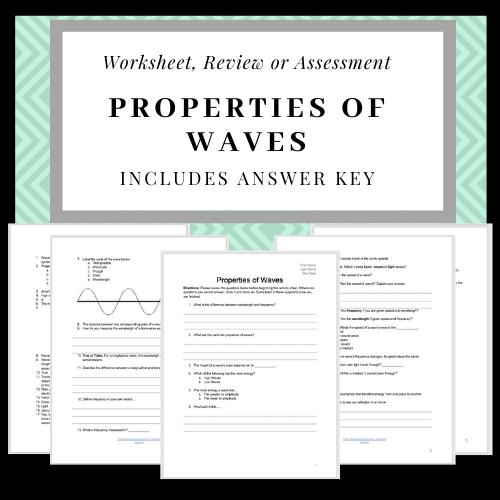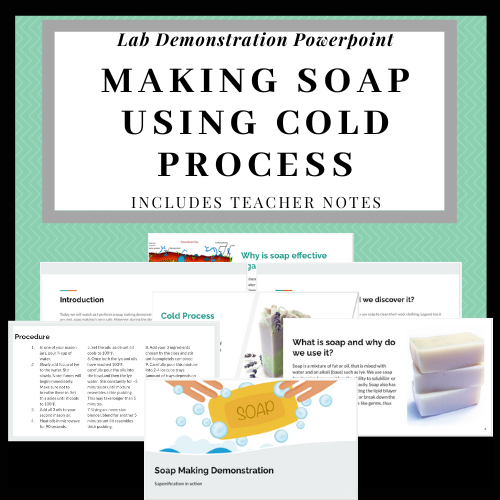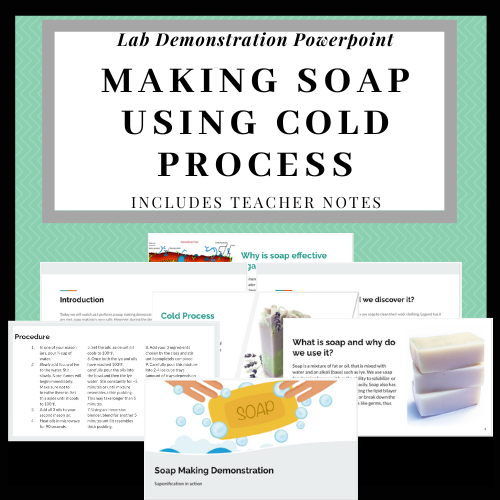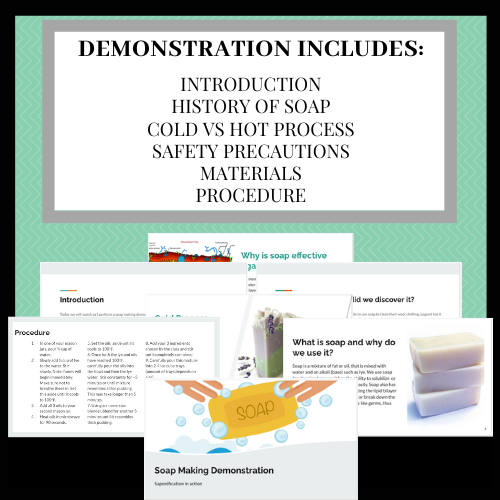Details
Pages
27 Pages
Subject
Science, Chemistry
Product
Digital
Grade
7th, 8th, 9th, 10th, 11th, 12th, Adult Ed
Resource Type
Activities, Laboratory, Lectures
Description
This resource is my 27 slide powerpoint that walks you through a demonstration of how soap is made through the cold process. Using this resource, a teacher will be able to create soap in front of the classroom in order to bring the chemistry of the saponification process to life. In my classroom, I printed the slides off for each student in order for them to answer the embedded questions directly within the presentation. Embedded questions keep the students focused and active during the demonstration.
This powerpoint includes the following:
Introduction to soap & its effectiveness against germs
History of soap
Molecular overview of soap
Germs & their lipid bilayers
Triglycerides
Saponification process
Cold vs hot process
Safety precautions when making soap
List of Materials
Detailed Procedure
Warm up/exit tickets
Materials needed:
Eye and hand protection
Oils such as canola or coconut oil
100% lye crystals (found at your local hardware store)
Surface covering such as newspaper
Steel or glass bowl
⅓ and ¼ measuring cups
Silicone spatula
Silicone/metal spoon
Soap mold (ice cube tray works- just don't use it again for ice). If using ice cube trays you will need 2-4 per class depending on the size of the trays and number of students in your class.
Mason jars (quart size)
Microwave or another apparatus to heat up oil
Thermometer
Immersion blender
Towels
Plastic wrap
Wire rack or cardboard for placing soap to cure
Vinegar- to neutralize the lye for cleaning the materials
Powerpoint questions printed off for students
Format:
-Easy step by step procedure
-Includes questions throughout the powerpoint so students may stay engaged during the demonstration.
-Educational videos included in ppt to differentiate learning
-Works well to really help kids understand the saponification process and how triglycerides react with an alkali base to form a product like soap
-Includes teacher notes throughout the powerpoint and additional resource links
-Editable powerpoint
I made the soap using ice cub trays as a mold. The recipe I followed for this demonstration made enough for 25 students using that type of mold, and after 4 weeks of curing the students were able to take their piece of soap home. You may multiply this recipe to meet the needs of your classroom size if you wish to let them take the soap home.
What is Cold Process Soap?
Cold process soap is soap made by mixing oils/fats with sodium hydroxide (lye) and water. This reaction is called saponification. In this process saponification happens on its own after being placed in a mold. Please note: "cold process" is a bit misleading; you will need to heat the oil/fat up to ~100 degrees Fahrenheit in order to stimulate the reaction with the lye and produce smooth and solid soap. If you don't do this, the soap may turn out crumbly. There are recipes online that don't require you to heat the oil, but I have never used those in my years of soap making and therefore cannot recommend them.
This powerpoint includes the following:
Introduction to soap & its effectiveness against germs
History of soap
Molecular overview of soap
Germs & their lipid bilayers
Triglycerides
Saponification process
Cold vs hot process
Safety precautions when making soap
List of Materials
Detailed Procedure
Warm up/exit tickets
Materials needed:
Eye and hand protection
Oils such as canola or coconut oil
100% lye crystals (found at your local hardware store)
Surface covering such as newspaper
Steel or glass bowl
⅓ and ¼ measuring cups
Silicone spatula
Silicone/metal spoon
Soap mold (ice cube tray works- just don't use it again for ice). If using ice cube trays you will need 2-4 per class depending on the size of the trays and number of students in your class.
Mason jars (quart size)
Microwave or another apparatus to heat up oil
Thermometer
Immersion blender
Towels
Plastic wrap
Wire rack or cardboard for placing soap to cure
Vinegar- to neutralize the lye for cleaning the materials
Powerpoint questions printed off for students
Format:
-Easy step by step procedure
-Includes questions throughout the powerpoint so students may stay engaged during the demonstration.
-Educational videos included in ppt to differentiate learning
-Works well to really help kids understand the saponification process and how triglycerides react with an alkali base to form a product like soap
-Includes teacher notes throughout the powerpoint and additional resource links
-Editable powerpoint
I made the soap using ice cub trays as a mold. The recipe I followed for this demonstration made enough for 25 students using that type of mold, and after 4 weeks of curing the students were able to take their piece of soap home. You may multiply this recipe to meet the needs of your classroom size if you wish to let them take the soap home.
What is Cold Process Soap?
Cold process soap is soap made by mixing oils/fats with sodium hydroxide (lye) and water. This reaction is called saponification. In this process saponification happens on its own after being placed in a mold. Please note: "cold process" is a bit misleading; you will need to heat the oil/fat up to ~100 degrees Fahrenheit in order to stimulate the reaction with the lye and produce smooth and solid soap. If you don't do this, the soap may turn out crumbly. There are recipes online that don't require you to heat the oil, but I have never used those in my years of soap making and therefore cannot recommend them.
This resource is my 27 slide powerpoint that walks you through a demonstration of how soap is made through the cold process. Using this resource, a teacher will be able to create soap in front of the classroom in order... more
0
Overall review score
Displaying All Reviews | 0 Reviews
0
0%
0
0%
0
0%
0
0%
0
0%
More from this shop

3
(1)
Free

$3.00

$3.99

$1.50

$1.50

$3.00

$3.75

$1.25

$1.25

$4.00

Free

$1.25

$1.00

$2.50

$3.99
Similar items

$3.00

$15.99

$15.99

$15.99

$15.99

$15.99

$15.99

$15.99









